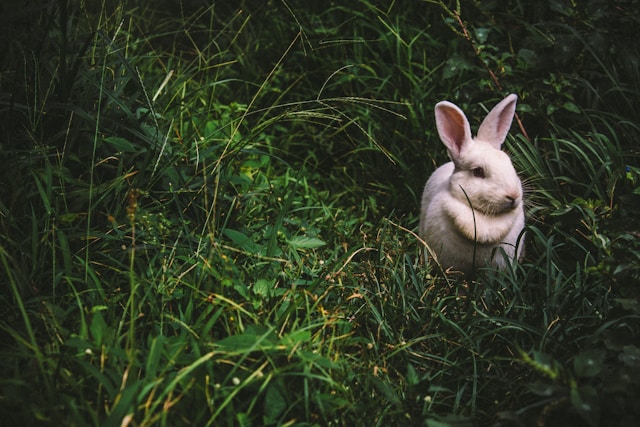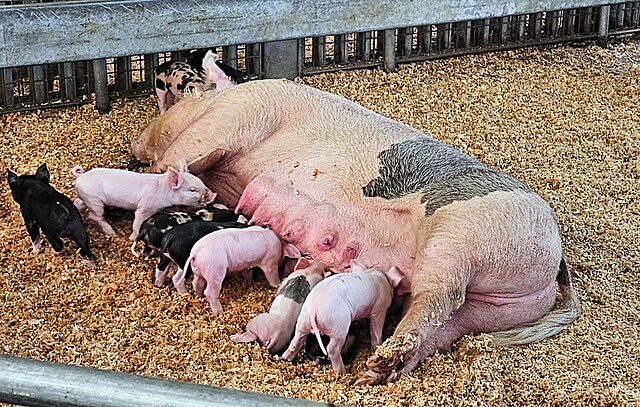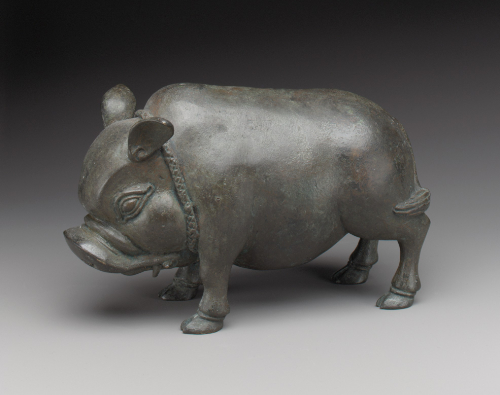Pigs appear in folklore in somewhat unusual ways. Sometimes, they choose the location where a church should be built. Or they appear as phantoms, haunting misty moorland.
Sailors or fishermen considered pigs unlucky, and wouldn’t even say ‘pig’ at sea. If they met a pig on their way to the boat, they would postpone sailing. Some of them went so far as to ban pork products on board. While this superstition seems inexplicable on the surface, Jacqueline Simpson suggests it comes from the biblical association between pigs and uncleanliness (2007: 278).
Some believed pigs can’t swim (they can, they’re very good at it), and that they can see the wind (Simpson 2007: 278). So what other strange things have people thought about pigs and collected into folklore? Let’s find out.
(There is actually a lot of fascinating lore about wild boars in folklore, but as we’re looking at agricultural animals, I’ve decided to keep the focus on pigs. We can come back to boars in the future!)
The Bewitched Pig
In 1853, a man in Bridgwater in Somerset became convinced his pig was bewitched. He consulted a cunning woman and she gave him a way to end the bewitchment. He needed to draw blood from the pig’s ears and trotters and let it drip onto a cloth he’d pierced with two crossed pins. Finally, he should burn the cloth and recite something from the Bible. The man followed the instructions and the pig recovered.
Incidentally, the man and his neighbours came to suspect an old woman who kept asking after the pig’s health. After seeing a white rabbit running along the lane every evening, which always disappeared by the woman’s cottage, they became sure the woman was the witch behind the pig’s enchantment. They trapped the rabbit and the man kicked it, although it escaped. They never saw the rabbit again, but they did notice the old woman stayed at home for three days, apparently unable to walk.

Jennifer Westwood notes that the counter-witchcraft is unusual, compared to the charm followed by the owner of the bewitched cow we looked at last week. Given this, and the fact witches were believed to turn into hares, not rabbits, Westwood suggests the story was based on something that happened, rather than being a variation on a legend (2005: 638). That said, William Henderson recorded a version in Yorkshire in which a pig owner believed his pigs to be bewitched by an elderly neighbour. He’d seen a suspicious-looking cat in his yard, and considered it was the witch in disguise. He threw a poker at the cat, which disappeared and the old woman apparently broke her leg the same night (1879: 206).
Henderson also recorded a story from Sunderland, sent to him by a physician named Dr Johnson, involving pigs. Apparently, locals in his area accused an elderly woman of bewitching a child, but in two ways. First, they accused her of casting the evil eye, but they also noticed the sickly nature of her pigs. According to them, she tried to transfer the sickness from the animals into the bewitched child. The letter does not explain if she succeeded, but the doctor referred to a belief that parents of sick children might use magic to transfer that sickness to other children (1879: 188).
Wild Pigs under London
In the 1860s, an urban legend circulated that wild pigs lived in the sewers under Hampstead in London. As the story went, a pregnant sow somehow found her way into a sewer, but couldn’t get back out. She gave birth in the sewers, and raised her offspring on the rubbish washed along the drain. As the legend would have you believe, the pigs interbred and became ferocious monsters (Westwood 2005: 470).
No one ever reported seeing or hearing pigs under drain covers. Victorian London had a class of men called sewer hunters who entered sewers looking for reusable materials, those things accidentally lost down drains, like coins or cutlery. While they told wild tales of the pigs in the sewers, no one ever reported encountering one. This is an ancestor of the American urban legend that emerged in the 1960s, particularly in New York, in this version, people flushed baby alligators down the toilet, and they roamed the sewers as fully-grown adults.
Location, Location, Location
There’s a theme within folklore involving pigs revealing the location where someone must build a church. In Braunton in Devon, a legend tells that St Brannoc received a vision to cross the sea and watch out for a sow with piglets. He should build a church on the site of the meeting with the sow. A separate version explains that St Brannoc kept trying to build his church in one location, only for the sow and piglets to undo his hard work and move the stones to its current location during the night. The legend apparently explains the presence of a roof-boss featuring a sow (Westwood 2005: 181).
We also see this legend-type in Winwick in Lancashire, involving a single pig. In this one, the church founder picked a site and laid the foundations on the spot. A pig turned up during the night and moved the stones one at a time to a spot sanctified by St Oswald’s death. Eventually, the founder decided to move the church to the latter site. You can still see a pig sculpture on the church tower in honour of the legend (Westwood 2005: 412). Other versions of the story claim a monstrous pig plagued the area, and only building the church controlled its power.

Other versions see either the Devil or fairies dismantling the church before it is finally built in whichever location the stones are left. It’s unclear as to why a pig would choose the location in these Devon and Lancashire stories. An alternative version in Northumberland explains why Callaly Castle stands in a vale, and not on the hill, where Lord Callaly wanted to build it.
Yet the Callaly Castle legend has a version in which Lady Callaly dressed a servant as a boar and sent him to pull down the building work every night (North of the Tyne 2007-2022). Master James, the castle-builder, saw the boar, and told Lord Callaly about it. When the lord likewise heard the boar yell advice that the castle would be better off in the dale, Lord Callaly obeyed. It’s unclear if this version of the story riffs on the existing ‘pigs choosing the site of a church’ legend, and simply relocates it to a castle. The fact it is a man dressed as a boar reveals Lady Callaly’s intentions!
But back to sows as location portents! There is precedent for this in the Aeneid. When Aeneas leaves Troy and arrives at the Tiber, he meets the river god in a dream. The god tells him he will see a sow with thirty piglets the next day, which foretells the founding of Alba Longa by his son in thirty years’ time. It all works out exactly as the god says (Westwood 2005: 181).
Spectral Pigs
Dartmoor unsurprisingly boasts tales of phantom pigs. One of them is a sow with a litter of piglets. They’re seen on foggy nights, travelling from Merripit Hill to Cator Gate, trotting along because they’ve heard a dead horse lies at Cator. The piglets cry out, “Starvin’, starvin'”, to which their mother replies, “Cator Gate, Cator Gate, Dead Hoss, Dead Hoss, Dead Hoss” (Westwood 2005: 197).
When they get there, they discover someone has beaten them to the dead horse, and the piglets squeal “Skin an’ bones, Skin an’ bones”. Their mother replies, “Let ‘en lie, let ‘en lie” (Westwood 2005: 197). The group returns to Merripit Hill, but they become emaciated on the route, dissolving into the mist before they reach their destination (Barber 1990: 14).

According to Elizabeth Warne, who related the tale to folklorist Theo Brown in 1949, people had seen this play out for two hundred years (Westwood 2005: 197).
While this story is quite sad, the other phantom pig is not sympathetic in the least. It is a giant black pig, believed to be the notorious Judge Jeffreys in porcine form. As George Jeffreys in life, he became infamous for harsh sentencing following the Monmouth Rebellion of 1685. No one knows why he takes the form of a pig, or indeed how anyone knows the pig is Judge Jeffreys, but he does also haunt a hotel room in Exeter in human form (Barber 1990: 14).
Death Pigs
Long-time readers will know I have a long-abiding fascination with death omens. Cows provided some in last week’s article, and pigs are apparently not to be outdone by their bovine friends.
William Henderson described how, before John Borrow of Durham died, people saw a coach drawn by six black pigs (1879: 327). Naturally, phantom coaches are usually drawn by horses, but it seems pigs have the same effect.
Henderson also recorded a bizarre Sussex superstition that lions only mated once every seven years, and piglets would be stillborn during that seventh breeding year (1879: 24).
Piggy Banks
I couldn’t tackle pigs in folklore without looking at the humble piggy bank. After all, there’s no obvious reason why would we store our money inside an object shaped like a pig. The banks are often referred to as ‘still’ banks, meaning the pig does nothing when you deposit money in it. That’s as opposed to mobile banks, where the bank might take the shape of a monkey, you put a coin on the monkey’s hand, and it tips the hand towards the face, as if ‘eating’ the coin.
The earliest known money box dates to 2nd-century Greece, although in those days, they simply used boxes with slits in them. According to legend, people began making pots from a type of earthenware called pygg. People could drop coins into the pots through slits in the top (Allen 2021). Yet actual pig-shaped banks date to 12th-century Java, where they used pots shaped like boars to store money. In Java, pigs represented wealth, good luck, prosperity, and fertility.
Is it possible that over time, the ideas combined to create the piggy bank as we know it today?
Jacqueline Simpson notes that pigs may be lucky charms due to their use as money boxes (2007: 278). I wondered if we used them as money boxes because they were lucky.
Have you heard legends like this?
I would love to hear if you’ve heard similar legends where you are. It would be interesting to see how and where these stories travelled to, and how they changed once they ended up somewhere new! Feel free to leave a comment below if you’ve heard such stories in your neck of the woods.
References
Allen, Nathan (2021), ‘Why do we put money in pigs?’, Frame of Reference, https://medium.com/frame-of-reference/why-do-we-put-money-in-pigs-93b6543dc2a8. Accessed 12 February 2025.
Barber, Sally and Chips (1990), Dark and Dastardly Dartmoor, Exeter: Obelisk.
Henderson, William (1879), Notes on the folk-lore of the northern counties of England and the borders, London: W. Satchell, Peyton and Co.
North of the Tyne (2007 -2022), ‘Callaly Castle Old & New’, North of the Tyne, https://www.northofthetyne.co.uk/Callaly.html. Accessed 12 February 2025.
Simpson, Jacqueline and Steve Roud (2003), A Dictionary of English Folklore, Oxford: Oxford University Press (affiliate link).
Westwood, Jennifer and Simpson, Jacqueline (2005), The Lore of the Land: A Guide to England’s Legends, London: Penguin (affiliate link).
Nutty about folklore and want more?
Add your email below and get these posts in your inbox every week.
You'll also get my 5-step guide to protecting your home using folklore!







Judge Jeffreys seems busy!
He’s one of those proper villains of folklore!
As a vegan I feel wounded to even suggest this but how about folklore of butchers as the bonus episode. I apologise and think this is a good idea in same breath.
I’ll see if I can find anything! I’m not sure how much there will be.
Thankyou ,, ha I feel cursed by this rotten request but am also intrigued ..praying for some type of revenge of the slaughtered lore. Will have to create it if non. Hero ghost pigs. Talking of which felt so sad for the wondering pigs crying out in the Mist…bless em.
As a resident of Winwick I would add that the original site for the church was disrupted by the pig, so the builders relocated to the final location… the original site subsequently suffered from subsidence and hence the pig was credited with saving the church.
The pig is used as a symbol in the annual village celebrations
Ah very cool! Thank you!